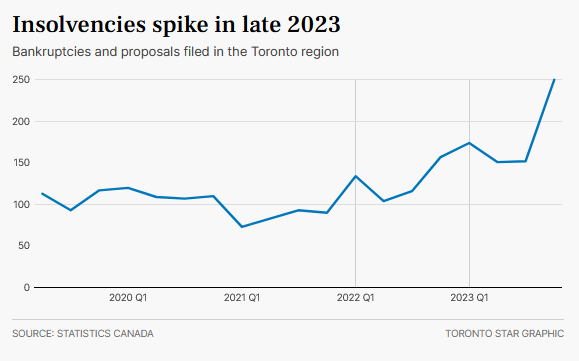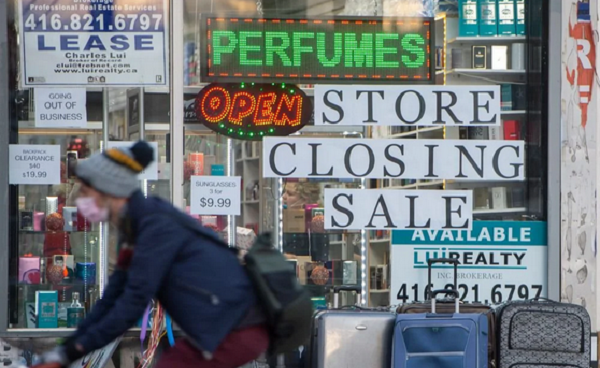Business closures rise by 41% in less than two years as pandemic aid fades – more to come, expert says
The post-COVID reckoning is here.
After several years of lower than normal numbers during the COVID-19 pandemic, the number of Canadian businesses filing for insolvency in 2023 skyrocketed to their highest level in 13 years. And some experts fear official numbers are just the tip of the iceberg.
A total of 4,810 businesses across the country filed for insolvency, up from 3,402 in 2022, a jump of 41 per cent from the 2,480 seen in 2021. And the head of the Canadian Association of Insolvency and Restructuring Professionals says this year could be even worse, thanks to the end of COVID-era financial aid programs, and consumers with significantly less disposable income.
Bolduc, a licensed insolvency professional, pointed in particular to the end of a grace period for businesses who took out government-backed loans under the Canada Emergency Business Account program.

As of Jan. 19, businesses who still had a balance remaining on their CEBA loans were faced with mandatory monthly payments and at least a 5 per cent interest rate on what had previously been an interest free-loan, with no scheduled monthly payments.
‘Those extra payments could put them under’
For struggling businesses, that could be the death knell, Bolduc said.
“Now they have to pay those CEBA loans back,” Bolduc said. “If they were surviving day-to-day already, those extra payments could put them under.”
Pandemic-era programs — including CEBA and the Canada Emergency Wage Subsidy — kept many businesses alive, especially in the hard-hit hospitality and retail sectors, said Bolduc. Now, they’re hanging on by a thread, if at all, Bolduc said.
“CEBA, the wage subsidies, that kept a lot of people afloat,” Bolduc said.
Higher interest rates introduced by the Bank of Canada in an attempt to control inflation has meant consumers have substantially less money to spend, said Bolduc. That’s one likely reason for a 23 per cent rise in consumer insolvencies last year, Bolduc said, noting that more than 123,000 Canadians filed for insolvency in 2023.
‘New hybrid work reality a harsh awakening’
Since March 2022, the Bank of Canada has raised interest rates 10 times pushing their key overnight lending rate up to 5 per cent, from 0.25 per cent. That means, among other things, higher mortgage payments, Bolduc said.
For small businesses who depend on downtown workers coming back to the office full-time, the new hybrid work reality has been a particularly harsh awakening, said Ryan Mallough, Ontario vice president with the Canadian Federation of Independent Business.
“If you’re a dry cleaner or a food court place that depended on those office towers being full Monday to Friday, you’re really struggling,” Mallough said. “We still don’t know exactly what the new normal is, but it’s not ever going back to the way it was.”
And Mallough fears that official insolvency numbers provided by the Office of the Superintendent of Bankruptcy tell only a fraction of the story. In member surveys, the CFIB has found that just 10 per cent of business owners said they would go through a formal insolvency process in the event they close their business. Many will simply walk away.
“I think it’s fair to call the official numbers the tip of the iceberg,” Mallough said.
‘Getting a lot more mental health calls’
There have been other troubling signs of distress among small business owners, Mallough said. In calls to the CFIB’s help line, designed to give them advice on how to navigate business issues, increasingly desperate owners are sharing tales of the personal toll the financial stress has taken on them.
“We were getting a lot more mental health calls as the CEBA deadline was approaching,” Mallough said. “And it was the worst kind of mental health calls too. People considering self-harm.”
For small business owners, there’s often more at stake than just revenue streams, or profit and loss statements, Mallough said. Giving up on their restaurant, or small shop, means giving up on something very personal.
“It’s their livelihoods, their dreams for the future. People have so much emotionally invested in their businesses,” Mallough said “You don’t start a small business unless you have a certain level of optimism and hope.”
“They will exhaust every opportunity to keep this business going, even if it’s something that takes a personal toll.”
This article was reported by The Star













